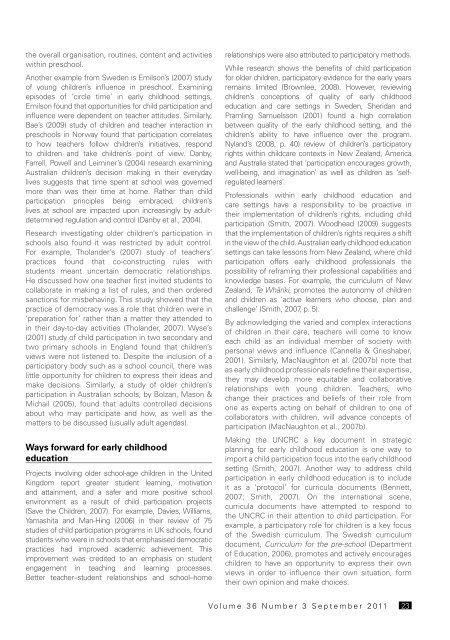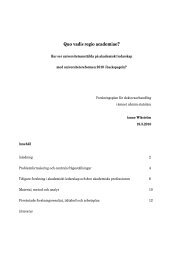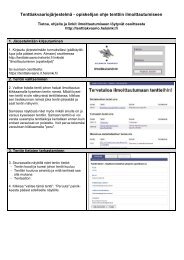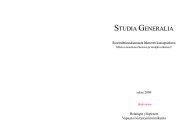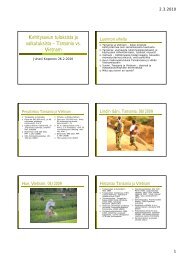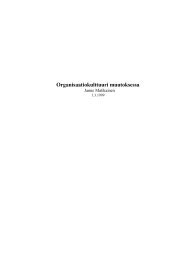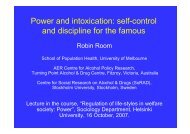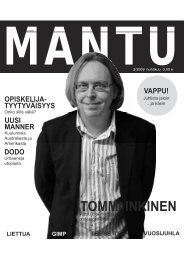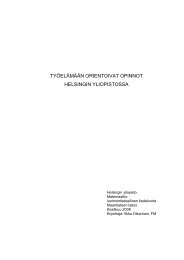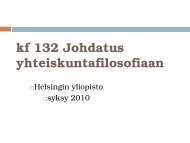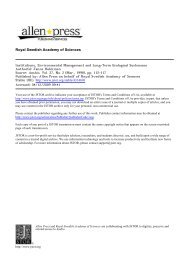to research and valuing children’s views (Freeman,1998, p. 434). Both perspectives take the view thatresearch should concentrate on the agency <strong>of</strong> childrenas constructors <strong>of</strong> their own social worlds; that childrenare persons and not property, subjects and not objects;and that they are participants in social processes ratherthan social problems themselves (Freeman, 1998).The reports <strong>of</strong> the Organisation for EconomicCooperation and Development (OECD), Starting strongand Starting strong II (2001; 2006), both emphasise thesignificance <strong>of</strong> child participation for political agendas.Starting strong (2001) identifies three early educationprograms that promote themes <strong>of</strong> child participation:the curriculum and pedagogy <strong>of</strong> Reggio Emilia (Italy), TeWhäriki (Ministry <strong>of</strong> Education, 1996), and Curriculumfor pre-school Lpfö 98 (Swedish National Agency forEducation, 1998). These case studies suggest that childparticipation and democratic principles are the basis <strong>of</strong>exemplary pedagogy and curricula in early childhoodeducation (Bennett & Leonarduzz, 2004; Pramling,2004; Rinaldi, 2006). Starting strong II (OECD, 2006)found further evidence that OECD countries withmore successful education systems are more likely tovalue children’s freedom <strong>of</strong> choice, play and creativeexpression (Bennett, 2007).An important part <strong>of</strong> engaging with children inconsultation practices involves informing them abouthow their ideas were used (MacNaughton, Hughes& Smith, 2009). There is little evidence <strong>of</strong> seriousreconsideration <strong>of</strong> planning and provision <strong>of</strong> earlychildhood services that enable young children tomake a difference (Hill et al., Tisdall, 2004; Mayall,2006). Nimmo (2007) suggests we have much tolearn regarding advancing young children’s genuineparticipation in real life. Many child participationprocesses, while attempting to ‘hear the voices’ <strong>of</strong>children, <strong>of</strong>ten fail to respond to children’s views(Kelley, 2006). Bae (2009) suggests that, while <strong>of</strong>ficialdocuments provide opportunities for child participation,it is now time to show how these possibilities are putto practice. Engaging young children as participants ineveryday social contexts remains a challenge.Impediments to participation in earlychildhood educationA central consideration in child participation debates,then, is not whether children and young people haveanything to say, but whether anyone is listening seriously(Holdsworth, 2005). There may be commitment to theidea <strong>of</strong> child participation in early childhood education,but transferring this idea into equitable practice iscomplex (Millei, 2008).The social processes and recognition <strong>of</strong> children ascapable beings is necessary to promote participatorypractice (Smith, Bjerke & Taylor, 2009). More than threedecades ago, Speier (1973) observed that children hadrestricted rights, and this view continues to resonatetoday, with studies observing that children lack statusin their world on adult terms. Bae (2009) notes that anemphasis on rules and procedures in early childhoodsettings may work to further limit children’s ‘free choice’and autonomy, and stifle children’s capacity to act asinteractional beings. Similarly, Nyland (2008) identifiesthat an emphasis on routines and schedules furtherimpedes participatory practices in early childhoodeducation settings.Significant portions <strong>of</strong> children’s daily activities takeplace in classrooms, yet the participation rights andsocial relations <strong>of</strong> young children remain impeded. Withan increasing focus on preparation for school (Bennett,2007), the Australian Federal Government’s visionfor education has a strong emphasis on academicimprovements for children with a ‘back to the basics’reform agenda in the new draft national curriculum(Maiden & Kelly, 2010). Within the draft AustralianCurriculum (ACARA, 2010), however, child participationis not identified as a key focus.It is difficult to find studies investigating participatoryprocesses in young children’s everyday affairs withinthe classroom and playground. MacNaughton et al.(2007b) propose that child participation is impededbecause early childhood pr<strong>of</strong>essionals are <strong>of</strong>ten viewedas child development experts. The challenge is to moveunderstandings <strong>of</strong> teachers being ‘experts’ in childdevelopment who know what is best for children in ageneral sense, to being expert in ways to collaboratewith children (MacNaughton et al., 2007b). Similarly,Bennett (2007) suggests that the balance <strong>of</strong> powerin education is rarely in favour <strong>of</strong> the child, owing toteacher attention to tasks such as socialising children,organising the environment and ensuring children’sreadiness for school, rather than attending to theirrights to consultation and participation (Bennett, 2007).The few international and national studies with a specificfocus on child participation in early childhood educationhave found children’s influence to be limited. PramlingSamuelsson and Pramling (2009) note that, while itmay be expected that early childhood education beresponsive to children’s influences, evidence suggestsotherwise. For example, Markström and Halldén (2008)observe, from their studies <strong>of</strong> Swedish preschools,that the very nature <strong>of</strong> preschool as an institutionmeans that tensions exist between individual children’sinterests and the interests <strong>of</strong> the larger group. Thestrategies used by children to exert their own influencein these settings are <strong>of</strong>ten overlooked. Sheridan andPramling Samuelsson’s (2001) study <strong>of</strong> early childhoodeducation and care settings in Sweden found thatchildren rarely participate in and make decisions about22A u s t r a l a s i a n J o u r n a l o f E a r l y C h i l d h o o d
the overall organisation, routines, content and activitieswithin preschool.Another example from Sweden is Emilson’s (2007) study<strong>of</strong> young children’s influence in preschool. Examiningepisodes <strong>of</strong> ‘circle time’ in early childhood settings,Emilson found that opportunities for child participation andinfluence were dependent on teacher attitudes. Similarly,Bae’s (2009) study <strong>of</strong> children and teacher interaction inpreschools in Norway found that participation correlatesto how teachers follow children’s initiatives, respondto children and take children’s point <strong>of</strong> view. Danby,Farrell, Powell and Leiminer’s (2004) research examiningAustralian children’s decision making in their everydaylives suggests that time spent at school was governedmore than was their time at home. Rather than childparticipation principles being embraced, children’slives at school are impacted upon increasingly by adultdeterminedregulation and control (Danby et al., 2004).Research investigating older children’s participation inschools also found it was restricted by adult control.For example, Tholander’s (2007) study <strong>of</strong> teachers’practices found that co-constructing rules withstudents meant uncertain democratic relationships.He discussed how one teacher first invited students tocollaborate in making a list <strong>of</strong> rules, and then orderedsanctions for misbehaving. This study showed that thepractice <strong>of</strong> democracy was a role that children were in‘preparation for’ rather than a matter they attended toin their day-to-day activities (Tholander, 2007). Wyse’s(2001) study <strong>of</strong> child participation in two secondary andtwo primary schools in England found that children’sviews were not listened to. Despite the inclusion <strong>of</strong> aparticipatory body such as a school council, there waslittle opportunity for children to express their ideas andmake decisions. Similarly, a study <strong>of</strong> older children’sparticipation in Australian schools, by Bolzan, Mason &Michail (2005), found that adults controlled decisionsabout who may participate and how, as well as thematters to be discussed (usually adult agendas).Ways forward for early childhoodeducationProjects involving older school-age children in the UnitedKingdom report greater student learning, motivationand attainment, and a safer and more positive schoolenvironment as a result <strong>of</strong> child participation projects(Save the Children, 2007). For example, Davies, Williams,Yamashita and Man-Hing (2006) in their review <strong>of</strong> 75studies <strong>of</strong> child participation programs in UK schools, foundstudents who were in schools that emphasised democraticpractices had improved academic achievement. Thisimprovement was credited to an emphasis on studentengagement in teaching and learning processes.Better teacher–student relationships and school–homerelationships were also attributed to participatory methods.While research shows the benefits <strong>of</strong> child participationfor older children, participatory evidence for the early yearsremains limited (Brownlee, 2008). However, reviewingchildren’s conceptions <strong>of</strong> quality <strong>of</strong> early childhoodeducation and care settings in Sweden, Sheridan andPramling Samuelsson (2001) found a high correlationbetween quality <strong>of</strong> the early childhood setting, and thechildren’s ability to have influence over the program.Nyland’s (2008, p. 40) review <strong>of</strong> children’s participatoryrights within childcare contexts in New Zealand, Americaand Australia stated that ‘participation encourages growth,well-being, and imagination’ as well as children as ‘selfregulatedlearners’.Pr<strong>of</strong>essionals within early childhood education andcare settings have a responsibility to be proactive intheir implementation <strong>of</strong> children’s rights, including childparticipation (Smith, 2007). Woodhead (2009) suggeststhat the implementation <strong>of</strong> children’s rights requires a shiftin the view <strong>of</strong> the child. Australian early childhood educationsettings can take lessons from New Zealand, where childparticipation <strong>of</strong>fers early childhood pr<strong>of</strong>essionals thepossibility <strong>of</strong> reframing their pr<strong>of</strong>essional capabilities andknowledge bases. For example, the curriculum <strong>of</strong> NewZealand, Te Whäriki, promotes the autonomy <strong>of</strong> childrenand children as ‘active learners who choose, plan andchallenge’ (Smith, 2007, p. 5).By acknowledging the varied and complex interactions<strong>of</strong> children in their care, teachers will come to knoweach child as an individual member <strong>of</strong> society withpersonal views and influence (Cannella & Grieshaber,2001). Similarly, MacNaughton et al. (2007b) note thatas early childhood pr<strong>of</strong>essionals redefine their expertise,they may develop more equitable and collaborativerelationships with young children. Teachers, whochange their practices and beliefs <strong>of</strong> their role fromone as experts acting on behalf <strong>of</strong> children to one <strong>of</strong>collaborators with children, will advance concepts <strong>of</strong>participation (MacNaughton et al., 2007b).Making the UNCRC a key document in strategicplanning for early childhood education is one way toimport a child participation focus into the early childhoodsetting (Smith, 2007). Another way to address childparticipation in early childhood education is to includeit as a ‘protocol’ for curricula documents (Bennett,2007; Smith, 2007). On the international scene,curricula documents have attempted to respond tothe UNCRC in their attention to child participation. Forexample, a participatory role for children is a key focus<strong>of</strong> the Swedish curriculum. The Swedish curriculumdocument, Curriculum for the pre-school (Department<strong>of</strong> Education, 2006), promotes and actively encourageschildren to have an opportunity to express their ownviews in order to influence their own situation, formtheir own opinion and make choices.Vo l u m e 3 6 N u m b e r 3 S e p t e m b e r 2 011 23
- Page 3 and 4: 1.5 Display, download or print the
- Page 5 and 6: Volume 36 Number 3 September 2011Jo
- Page 7 and 8: Curriculum guidelines for early lit
- Page 9 and 10: ■■Know that print carries meani
- Page 14 and 15: Korean children’s cultural adjust
- Page 16 and 17: The Early Years Learning Framework
- Page 18: Kyung Min said listening in class w
- Page 21 and 22: immediately impact on children’s
- Page 23 and 24: Child participation in the early ye
- Page 25: their kindergarten day. A study by
- Page 29 and 30: Council of Australian Governments (
- Page 31: Learning to measure length in the f
- Page 34 and 35: ■■a 40-minute, one-on-one inter
- Page 36 and 37: ■■72 per cent of the project sc
- Page 38 and 39: In other words, the difficulties th
- Page 40 and 41: An analysis of New Zealand’s chan
- Page 42 and 43: Before five also gave equivalent st
- Page 44 and 45: some evidence that curriculum effec
- Page 46 and 47: achievement; aiding transition to s
- Page 49 and 50: ‘It’s a mystery!’A case study
- Page 51: analysis of discourse the children
- Page 56 and 57: ange of objects on the floor (such
- Page 58 and 59: Observation and recording informati
- Page 60 and 61: ‘I’m making it different to the
- Page 62 and 63: Purpose and theoretical frameworkIn
- Page 64 and 65: The fingers were reaching out acros
- Page 66 and 67: Figure 7. ‘I take this lovely lad
- Page 68 and 69: Here, Rachel used substitution to r
- Page 70: Evaluating the feasibility, effecti
- Page 73 and 74: Table 2. Descriptive characteristic
- Page 75 and 76: The children in this study were fro
- Page 77 and 78:
Vol. 36 No. 3 September 2011Austral
- Page 79 and 80:
implement the curriculum effectivel
- Page 81 and 82:
Table 2. Mean differences between H
- Page 83 and 84:
can be regarded as one of the infor
- Page 85 and 86:
Ganser, T. (2000). An ambitious vis
- Page 87 and 88:
(Buckhalt et al., 2009). Reduced qu
- Page 89 and 90:
invited families having difficulty
- Page 91 and 92:
Table 3. Mean hours of mother and f
- Page 93 and 94:
A reduction in night wakings might
- Page 95 and 96:
A preliminary exploration of childr
- Page 97 and 98:
adult support necessary for its eff
- Page 99 and 100:
Children’s cortisol and alpha-amy
- Page 102 and 103:
Connor, C., Son, S.-H., Hindman, A.
- Page 104 and 105:
Equity of access:Requirements of In
- Page 106 and 107:
excursions, which have been reporte
- Page 108 and 109:
We need a bus but we also need a st
- Page 110 and 111:
Appropriate child careIndigenous fa
- Page 112 and 113:
Australian Institute of Health and
- Page 114 and 115:
The Mosaic Approach relies on child
- Page 116 and 117:
participants (Altrichter, Posch, &
- Page 118 and 119:
distance. This involved trying to b
- Page 120 and 121:
Dockett, S., & Perry, B. (2003). Ch
- Page 122 and 123:
experiences (Bandura, 1997). Belief
- Page 124 and 125:
the curriculum while on their profe
- Page 126 and 127:
Exploring and evaluating levels of
- Page 128 and 129:
Level 2: Attending to feelingsThis
- Page 130 and 131:
This process to ensure coder stabil
- Page 132 and 133:
DiscussionStructured reflective pro
- Page 134 and 135:
Rock, T. C., & Levin, B. B. (2002).
- Page 136 and 137:
issues encountered in their caring
- Page 138 and 139:
pertaining to the impact and suppor
- Page 140 and 141:
Parents felt the policies involving
- Page 142 and 143:
and access suitable carers because
- Page 144 and 145:
Ievers, C. E., & Drotar, D. (1996).
- Page 146:
www.earlychildhoodaustralia.org.auE


